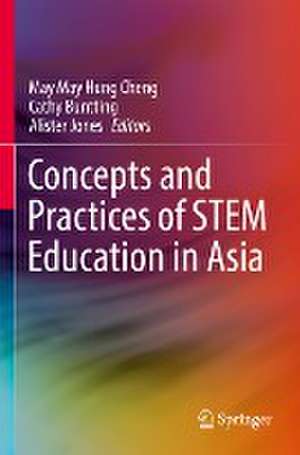Concepts and Practices of STEM Education in Asia
Editat de May May Hung Cheng, Cathy Buntting, Alister Jonesen Limba Engleză Paperback – 22 oct 2023
Chapters "An Overview of STEM Education in Asia" and "STEM Teacher Professional Development for Primary School Teachers in Hong Kong" are available open access under a CC BY 4.0 license at link.springer.com.
| Toate formatele și edițiile | Preț | Express |
|---|---|---|
| Paperback (1) | 726.85 lei 6-8 săpt. | |
| Springer Nature Singapore – 22 oct 2023 | 726.85 lei 6-8 săpt. | |
| Hardback (1) | 732.84 lei 6-8 săpt. | |
| Springer Nature Singapore – 21 oct 2022 | 732.84 lei 6-8 săpt. |
Preț: 726.85 lei
Preț vechi: 886.41 lei
-18% Nou
Puncte Express: 1090
Preț estimativ în valută:
139.08€ • 145.60$ • 115.08£
139.08€ • 145.60$ • 115.08£
Carte tipărită la comandă
Livrare economică 05-19 aprilie
Preluare comenzi: 021 569.72.76
Specificații
ISBN-13: 9789811925986
ISBN-10: 9811925984
Pagini: 287
Ilustrații: IX, 287 p. 28 illus., 17 illus. in color.
Dimensiuni: 155 x 235 mm
Greutate: 0.42 kg
Ediția:1st ed. 2022
Editura: Springer Nature Singapore
Colecția Springer
Locul publicării:Singapore, Singapore
ISBN-10: 9811925984
Pagini: 287
Ilustrații: IX, 287 p. 28 illus., 17 illus. in color.
Dimensiuni: 155 x 235 mm
Greutate: 0.42 kg
Ediția:1st ed. 2022
Editura: Springer Nature Singapore
Colecția Springer
Locul publicării:Singapore, Singapore
Cuprins
Introduction.- Part I Conceptualising STEM education in Asia.- 1 Identifying Effective STEM Programmes and Strategies in Asia.- 2 Interdisciplinary, Integrated, and Transdisciplinary Approaches to Science and Technology Education: When, for Whom, and How?.- 3 Arts Integrated STEM in Korea.- 4 The Status Study of the Researches & Practices on STEM Education Towards Society 5.0 in Japan.- 5 The Consumption and Production of STEM Education in Singapore.- Part II Implementing STEM Education at Different Education Levels in Asia.- 6 Fostering STEM Education for Early Childhood in Thailand.- 7 Innovative Flat Speaker STEM Curriculum for Enhancing Students’ Engineering Design and Their Attitudes towards STEM.- 8 Online Real-time Experiments for Enhancing Learning of Interdisciplinary and Disciplinary STEM Subjects at the Secondary Level.- 9 Enhancing STEM Education in Malaysia Through Scientist-teacher-student Partnership (STSP).- 10 Revitalizing STEM Education in Rural Secondary Schools through Mentor-Mentee Outreach Program.- 11 Student Research Tasks on STEM/STEAM and its Educational Effects in Korea.- Part III Preparing teachers for STEM teaching.- 12 Toward STEM Education in Pre-service Math-Science Teacher Program in Indonesia: A Challenging Journey.- 13 Teacher Training and Preparation for STEM Teaching: Challenge and Recommendation.- Epilogue: Way forward for STEM Education in Asia.
Notă biografică
Professor May Cheng May Hung is currently Associate Vice President (Academic Affairs), Registrar and Chair Professor of Teacher Education of The Education University of Hong Kong. She was President of the East Asian Association for Science Education (EASE) from 2016 to 2018. Her main areas of research are teacher education and science education. She researches in inquiry learning, assessment for learning, and the nature of science, with a focus on teacher learning and teacher professional development.
Dr Cathy Buntting is Director of the Wilf Malcolm Institute of Educational Research at the University of Waikato, New Zealand. Her research interests straddle science, technology and STEM education across the school years, with a strong focus on innovative approaches to education in these disciplines. She has directed a range of government-funded research and development projects, including the award-winning Science Learning Hub which uses digital innovationto link the education and STEM sectors.
Professor Alister Jones is a research professor and the senior deputy vice-chancellor at the University of Waikato, New Zealand. He has written extensively on curriculum development in both science and technology education in New Zealand and been consulted on educational development in New Zealand, Australia, the United Kingdom, USA, Hong Kong, China, Thailand and Chile, and co-chaired an APEC working group on science and mathematics education.
Textul de pe ultima copertă
The purpose of this edited book is to enrich the literature related to STEM education at kindergarten, primary and secondary levels in Asia, with particular attention given to the analysis of the educational context in a number of Asian countries, including STEM-related policies, pedagogical practices, and the design and evaluation of STEM programmes. The discussions look into impacts on student learning outcomes and the ways in which STEM education is catering for schools and students’ interests and needs. The contributors are experts in STEM education or are leading major research and development projects in STEM in their regions. The book’s first section is focused at the macro-level on the conceptualization and formulation of STEM education policies in different regions, contributing to our understanding of the current status of STEM education in Asia. The second section examines some features of STEM learning and teaching at the classroom level and includes studies on student learning in STEM programmes. Pedagogical innovations implemented in different parts of Asia are also reported and discussed. The third section moves to teacher education and teacher professional development. It discusses practices of teacher professional development in the region and reports on current provisions as well as challenges. Together, the contributions from different Asian regions invite researchers and educators to learn from effective STEM practices, and point out areas for further development.
Chapters "An Overview of STEM Education in Asia" and "STEM Teacher Professional Development for Primary School Teachers in Hong Kong" are available open access under a CC BY 4.0 license at link.springer.com.
Caracteristici
Introduces specific resources and strategies, which can be a useful reference for STEM education Examines features of STEM learning and teaching at early childhood, primary and secondary levels across Asia Concludes with implications for designing STEM programmes and future research
